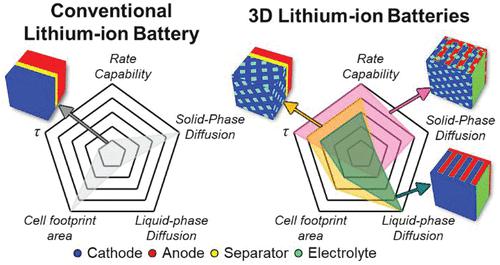当前位置:
X-MOL 学术
›
ACS Energy Lett.
›
论文详情
Our official English website, www.x-mol.net, welcomes your
feedback! (Note: you will need to create a separate account there.)
Are Three-Dimensional Batteries Beneficial? Analyzing Historical Data to Elucidate Performance Advantages
ACS Energy Letters ( IF 19.3 ) Pub Date : 2022-11-30 , DOI: 10.1021/acsenergylett.2c02208 Chih-Hsuan Hung 1 , Phong Huynh 1 , Katrina Teo 1 , Corie L. Cobb 1
ACS Energy Letters ( IF 19.3 ) Pub Date : 2022-11-30 , DOI: 10.1021/acsenergylett.2c02208 Chih-Hsuan Hung 1 , Phong Huynh 1 , Katrina Teo 1 , Corie L. Cobb 1
Affiliation

|
Conventional lithium-ion batteries (LIBs) are composed of planar stacks of anodes, cathodes, and separators, all immersed in electrolyte and sandwiched between current collectors. However, planar LIBs have a performance trade-off where increasing electrode thickness leads to higher capacity but lower rate capability. Three-dimensional (3D) batteries circumvent this issue with 3D electrode architecture. Herein, we systematically analyze 3D LIBs from experimental publications over the past 20 years. Using a previously developed empirical model, we obtain parameters to quantify the rate capability and rate-limiting mechanisms of 3D LIBs. Compared to conventional LIBs, 3D LIBs exhibit better rate capability─confirming their expected performance benefit. To provide further insight, we investigate the impact of liquid-phase and solid-phase diffusion mechanisms on this performance benefit. Lastly, we discuss the design landscape of 3D LIBs across multiple electrode designs and material sets and highlight our perspective on the applicability of 3D LIBs at different application scales.
中文翻译:

三维电池有用吗?分析历史数据以阐明性能优势
传统的锂离子电池 (LIB) 由阳极、阴极和隔膜的平面堆叠组成,全部浸入电解质中并夹在集电器之间。然而,平面 LIB 有一个性能折衷,即增加电极厚度会导致更高的容量但更低的倍率能力。三维 (3D) 电池通过 3D 电极结构规避了这个问题。在此,我们系统地分析了过去 20 年实验出版物中的 3D LIB。使用先前开发的经验模型,我们获得了参数来量化 3D LIB 的速率能力和速率限制机制。与传统 LIB 相比,3D LIB 表现出更好的倍率能力─证实了它们的预期性能优势。为了提供进一步的见解,我们研究了液相和固相扩散机制对该性能优势的影响。最后,我们讨论了跨多个电极设计和材料组的 3D LIB 的设计前景,并强调了我们对 3D LIB 在不同应用规模的适用性的看法。
更新日期:2022-11-30
中文翻译:

三维电池有用吗?分析历史数据以阐明性能优势
传统的锂离子电池 (LIB) 由阳极、阴极和隔膜的平面堆叠组成,全部浸入电解质中并夹在集电器之间。然而,平面 LIB 有一个性能折衷,即增加电极厚度会导致更高的容量但更低的倍率能力。三维 (3D) 电池通过 3D 电极结构规避了这个问题。在此,我们系统地分析了过去 20 年实验出版物中的 3D LIB。使用先前开发的经验模型,我们获得了参数来量化 3D LIB 的速率能力和速率限制机制。与传统 LIB 相比,3D LIB 表现出更好的倍率能力─证实了它们的预期性能优势。为了提供进一步的见解,我们研究了液相和固相扩散机制对该性能优势的影响。最后,我们讨论了跨多个电极设计和材料组的 3D LIB 的设计前景,并强调了我们对 3D LIB 在不同应用规模的适用性的看法。











































 京公网安备 11010802027423号
京公网安备 11010802027423号